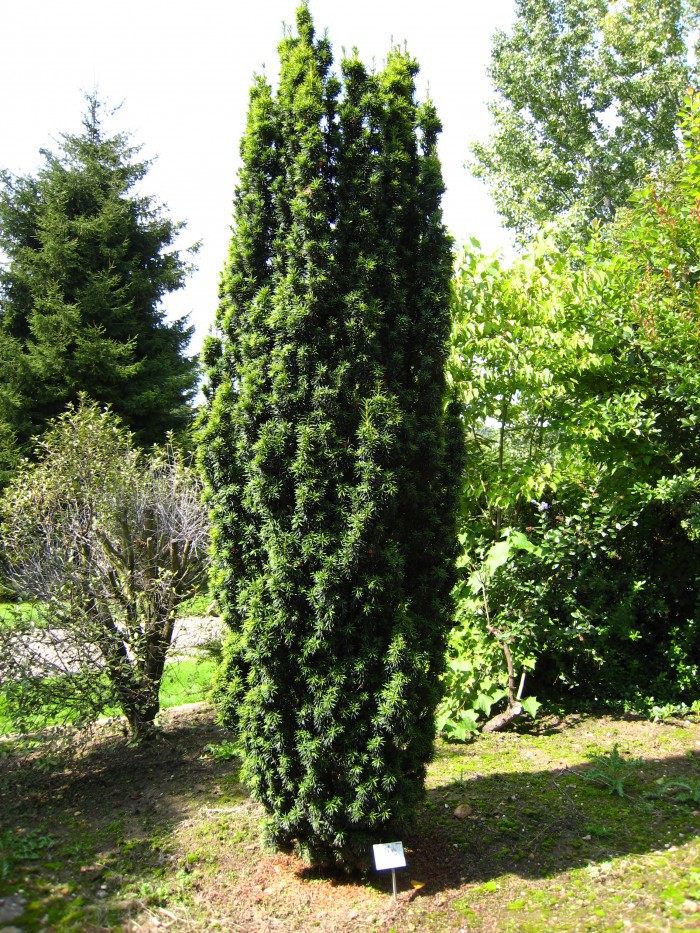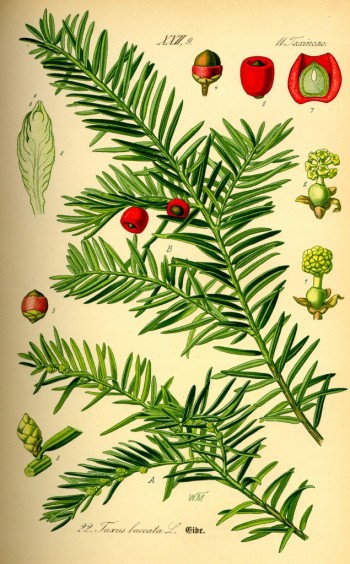Taxus, as described in 1753 by Carolus Linnaeus (1707 - 1778), in Species Plantarum 2, is a genus small coniferous trees or shrubs in the yew family, Taxaceae. All of the yews are very closely related to each other, and some botanists treat them all as subspecies or varieties of just one widespread species; under this treatment, the species name used is Taxus baccata, the first yew described scientifically. The genus name is thought to have been coined by Linnaeus, possibly derived from the Classical Greek word, toxon, a bow from Scythian, an unverified form tachŠ¡a - akin to Persian tachŠ¡, meaning bow or arrow. All of these terms refer to the historic use of Taxus wood in bow making.
The conifers of this genus are almost universally know as yews, from the middle English term ew from old English iw, eow, akin to German eibe (OHG iwa) from Indo-European an unverified form (e)iw?- from base an unverified form ei-, reddish from source Classical Latin uva, grape: origin, originally name because of color of the wood. In other languages, Taxus is commonly known as Eibe in the German language. In Iran, the tree is known as sorkhdÄr (Persian: سرخدار'Ž, literally "the red tree").
Paleobotany. The oldest recognizable yew is the Triassic species, Paleotaxus rediviva, found in strata 200 million years old. The mid-Jurassic species Taxus jurassica (140 million years old) is more recognizable as a member of Taxus, containing features characteristic of T. baccata, T. cuspidata, and T. brevifolia. A Quaternary yew, Taxus grandis, is probably simply T. baccata
Description. Yews are relatively slow-growing and can be very long-lived, reaching mature heights of 3 to 120 feet (1 - 40 m), with trunk diameters of up to 12 feet (4 m), measured at breast height.
The most distinct yew species are the Sumatran yew (T. sumatrana), native to Sumatra and Celebes north to southernmost China, distinguished by its sparse, sickle-shaped yellow-green leaves. The Mexican yew (T. globosa), native to eastern Mexico south to Honduras is also relatively distinct with foliage intermediate between Sumatran yew and the other species. The Florida yew, Mexican yew and Pacific yew are all rare species listed as threatened or endangered.
All species of yew contain highly poisonous alkaloids known as taxanes, with some variation in the exact formula of the alkaloid between the species. All parts of the tree except the arils contain the alkaloid. The arils are edible and sweet, but the seed is dangerously poisonous; unlike birds, the human stomach can break down the seed coat and release the taxanes into the body. This can have fatal results if yew 'berries' are eaten without removing the seeds first. Grazing animals, particularly cattle and horses, are also sometimes found dead near yew trees after eating the leaves, though deer are able to break down the poisons and will eat yew foliage freely. In the wild, deer browsing of yews is often so extensive that wild yew trees are commonly restricted to cliffs and other steep slopes inaccessible to deer.
Yew wood is reddish brown (with whiter sapwood), and is very springy. It was traditionally used to make bows, especially the longbow. Most longbow wood used in northern Europe was imported from Iberia, where climatic conditions are better for growing the knot-free yew wood required. The yew longbow was the critical weapon used by the English in the defeat of the French cavalry at the Battle of Agincourt, 1415. It is suggested that English parishes were required to grow yews and, because of the trees' toxic properties, they were grown in the only commonly enclosed area of a village - the churchyard. The yew tree can often be found in church graveyards and is symbolic of sadness.


Yews are widely used in landscaping and ornamental horticulture. Over 400 cultivars of yews have been named, the vast majority of these being derived from Taxus baccata (European yew) or Taxus cuspidata (Japanese yew). The hybrid between these two species is Foundation yew (Taxus x media). A popular fastigiate selection of the European yew (Taxus baccata 'Fastigiata') is often called the Irish yew, which often exacerbates the difficulties with common names. A few cultivars with yellow leaves that are being propagated, collectively are known as golden yews, which is another nomenclature blunder.
The Pacific yew (Taxus brevifolia), native to the Pacific Northwest of North America, and Canada yew (Taxus canadensis) are the sources of paclitaxel or Taxol, a chemotherapeutic drug used in breast and lung cancer treatment and, more recently, in the production of the Taxus drug eluting stent by Boston Scientific. Over-harvesting of the Pacific yew for this drug led to fears that it would become an endangered species. However, methods were developed to produce the drug semi-synthetically from cultivated yews, without the need to further endanger the wild populations, and the Pacific yew is not endangered. The more common Canada yew, Taxus canadensis, is also being successfully harvested in northern Ontario, Québec and New Brunswick, and has become another major source of paclitaxel. Other yew species contain similar compounds with similar biochemical activity. Docetaxel, an analogue of paclitaxel, is derived from the Taxus baccata.
On January 18, 2008, the Botanic Gardens Conservation International (representing botanic gardens in 120 countries) stated that "400 medicinal plants are at risk of extinction, from over-collection and deforestation, threatening the discovery of future cures for disease." These included yew trees (the bark is used for cancer drugs, paclitaxel).